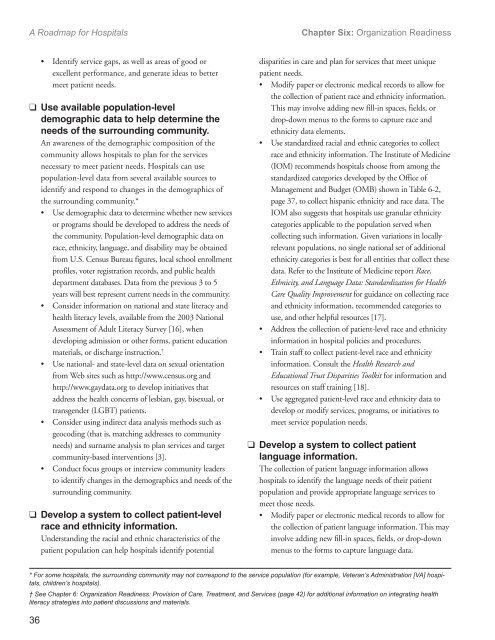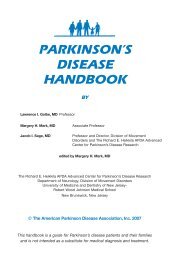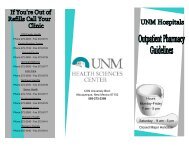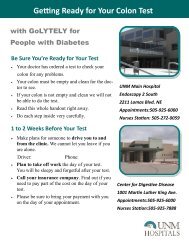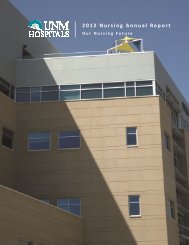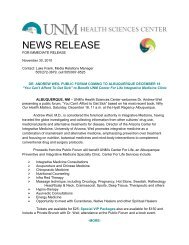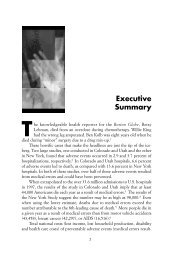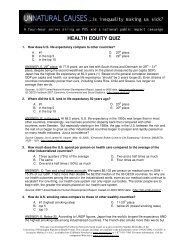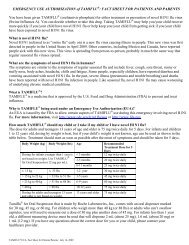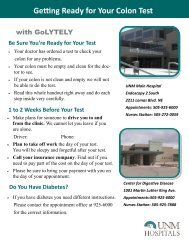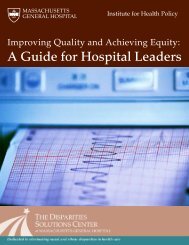Advanced Effective Communication, Cultural Competence, and ...
Advanced Effective Communication, Cultural Competence, and ...
Advanced Effective Communication, Cultural Competence, and ...
You also want an ePaper? Increase the reach of your titles
YUMPU automatically turns print PDFs into web optimized ePapers that Google loves.
A Roadmap for Hospitals<br />
Chapter Six: Organization Readiness<br />
• Identify service gaps, as well as areas of good or<br />
excellent performance, <strong>and</strong> generate ideas to better<br />
meet patient needs.<br />
❑ Use available population-level<br />
demographic data to help determine the<br />
needs of the surrounding community.<br />
An awareness of the demographic composition of the<br />
community allows hospitals to plan for the services<br />
necessary to meet patient needs. Hospitals can use<br />
population-level data from several available sources to<br />
identify <strong>and</strong> respond to changes in the demographics of<br />
the surrounding community.*<br />
• Use demographic data to determine whether new services<br />
or programs should be developed to address the needs of<br />
the community. Population-level demographic data on<br />
race, ethnicity, language, <strong>and</strong> disability may be obtained<br />
from U.S. Census Bureau figures, local school enrollment<br />
profiles, voter registration records, <strong>and</strong> public health<br />
department databases. Data from the previous 3 to 5<br />
years will best represent current needs in the community.<br />
• Consider information on national <strong>and</strong> state literacy <strong>and</strong><br />
health literacy levels, available from the 2003 National<br />
Assessment of Adult Literacy Survey [16], when<br />
developing admission or other forms, patient education<br />
materials, or discharge instruction. †<br />
• Use national- <strong>and</strong> state-level data on sexual orientation<br />
from Web sites such as http://www.census.org <strong>and</strong><br />
http://www.gaydata.org to develop initiatives that<br />
address the health concerns of lesbian, gay, bisexual, or<br />
transgender (LGBT) patients.<br />
• Consider using indirect data analysis methods such as<br />
geocoding (that is, matching addresses to community<br />
needs) <strong>and</strong> surname analysis to plan services <strong>and</strong> target<br />
community-based interventions [3].<br />
• Conduct focus groups or interview community leaders<br />
to identify changes in the demographics <strong>and</strong> needs of the<br />
surrounding community.<br />
❑ Develop a system to collect patient-level<br />
race <strong>and</strong> ethnicity information.<br />
Underst<strong>and</strong>ing the racial <strong>and</strong> ethnic characteristics of the<br />
patient population can help hospitals identify potential<br />
disparities in care <strong>and</strong> plan for services that meet unique<br />
patient needs.<br />
• Modify paper or electronic medical records to allow for<br />
the collection of patient race <strong>and</strong> ethnicity information.<br />
This may involve adding new fill-in spaces, fields, or<br />
drop-down menus to the forms to capture race <strong>and</strong><br />
ethnicity data elements.<br />
• Use st<strong>and</strong>ardized racial <strong>and</strong> ethnic categories to collect<br />
race <strong>and</strong> ethnicity information. The Institute of Medicine<br />
(IOM) recommends hospitals choose from among the<br />
st<strong>and</strong>ardized categories developed by the Office of<br />
Management <strong>and</strong> Budget (OMB) shown in Table 6-2,<br />
page 37, to collect hispanic ethnicity <strong>and</strong> race data. The<br />
IOM also suggests that hospitals use granular ethnicity<br />
categories applicable to the population served when<br />
collecting such information. Given variations in locally<br />
relevant populations, no single national set of additional<br />
ethnicity categories is best for all entities that collect these<br />
data. Refer to the Institute of Medicine report Race,<br />
Ethnicity, <strong>and</strong> Language Data: St<strong>and</strong>ardization for Health<br />
Care Quality Improvement for guidance on collecting race<br />
<strong>and</strong> ethnicity information, recommended categories to<br />
use, <strong>and</strong> other helpful resources [17].<br />
• Address the collection of patient-level race <strong>and</strong> ethnicity<br />
information in hospital policies <strong>and</strong> procedures.<br />
• Train staff to collect patient-level race <strong>and</strong> ethnicity<br />
information. Consult the Health Research <strong>and</strong><br />
Educational Trust Disparities Toolkit for information <strong>and</strong><br />
resources on staff training [18].<br />
• Use aggregated patient-level race <strong>and</strong> ethnicity data to<br />
develop or modify services, programs, or initiatives to<br />
meet service population needs.<br />
❑ Develop a system to collect patient<br />
language information.<br />
The collection of patient language information allows<br />
hospitals to identify the language needs of their patient<br />
population <strong>and</strong> provide appropriate language services to<br />
meet those needs.<br />
• Modify paper or electronic medical records to allow for<br />
the collection of patient language information. This may<br />
involve adding new fill-in spaces, fields, or drop-down<br />
menus to the forms to capture language data.<br />
* For some hospitals, the surrounding community may not correspond to the service population (for example, Veteran’s Administration [VA] hospitals,<br />
children’s hospitals).<br />
† See Chapter 6: Organization Readiness: Provision of Care, Treatment, <strong>and</strong> Services (page 42) for additional information on integrating health<br />
literacy strategies into patient discussions <strong>and</strong> materials.<br />
36


